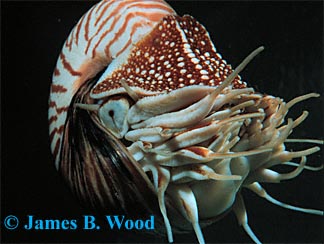
 |
| Home | What's New? | Cephalopod Species | Cephalopod Articles | Lessons | Bookstore | Resources | About TCP | FAQs |
Nautilus pompilius, Nautiluses<< Cephalopod SpeciesNautilus and Allonautilus are the last living genera of externally shelled cephalopods (Ward 1983 and 1987, CephBase 2002). These slow moving Cephalopods are considered primitive when compared to their faster moving relatives. In addition to having an external shell, these cephalopods do not have lenses in their eyes.  Nautiloids and ammonoids were once one of the dominant groups, both in terms of number of species and biomass, found in the ocean's of the world (See the Fossil Cephalopods FAQs). The remaining seven species of Nautilus and Allonautilus are living fossils. Nautiluses have been on the planet for 500 million years! The external shell of these animals provides both protection and rigid open spaces that can be filled with gas for buoyancy. Carlson et al (1984) reports that tagged Nautilus belauensis descend to a depth of 476 meters and move approximately 0.45-0.8 km in an average day. Unfortunately for Nautiluses, their are shells are attractive to humans and many are killed each year. Indonesia had banned the collection and export since 1987 but many other countries still collect and kill them. A small percentage are also taken for the aquarium trade. Dr. Peter Ward reports hearing that the situation New Caledonia is a catastrophe. Over a period of two years or less, 10,000 live Nautilus were captured and killed for their shells. One reason that nautiluses are not protected by CITES is that we don't have much scientific information on them. We do know that they have extremely slow reproductive rates, especially when compared to other cephalopods. Nautilus take perhaps 5 to 10 years to reach maturity and only lay a dozen or so eggs in a year. Once mature, Nautilus produce eggs over many years. This means that if their population is severely depressed it will take a long time for them to recover. In contrast, most cephalopods only live a year and produce many smaller offspring. Many cephalopods only reproduce once and die. At Dalhousie I've worked with nautiluses while investigating their activity patterns with Dr. Webber and Dr. O'Dor. I have to say, Nautilus are not much like squid, octopuses and cuttlefish. They are interesting for scientific reasons but they don't rapidly change color, are not as active and do not seem to be anywhere near as intelligent and responsive as the other cephalopods. They are basically swimming snails. These major differences are not surprisingly as they diverged from modern cephalopods before there were bony fish in the ocean. In aquaria they may live for a long time but they have buoyancy problems (they tend to float at the top) and problems producing new shell (the new shell is discolored, black and malformed). There are no known solutions to these problems. Only two places have ever had fertile eggs laid successfully in captivity; Waikiki Aquarium and an aquarium in Japan. A third aquarium in Austria may have also succeeded but I have not been able to validate this report. Nautilus eggs have never been found in the wild, no one has ever raised a hatchling to maturity in captivity. For these reasons they are not, in my opinion, a good pet choice for home aquarists. This is one of the reasons that I have chose to not write a popular article on their care in captivity.
References and CreditsCreditsPhotograph by Max Ress and James B. Wood.ReferencesNational Resource Center for Cephalopods (NRCC)
| ||||||||
| Home | What's New? | Cephalopod Species | Cephalopod Articles | Lessons | Resources | About TCP | FAQs | Site Map | |
 |
The Cephalopod Page (TCP), © Copyright 1995-2026, was created and is maintained by Dr. James B. Wood, Associate Director of the Waikiki Aquarium which is part of the University of Hawaii. Please see the FAQs page for cephalopod questions, Marine Invertebrates of Bermuda for information on other invertebrates, and MarineBio.org and the Census of Marine Life for general information on marine biology. |